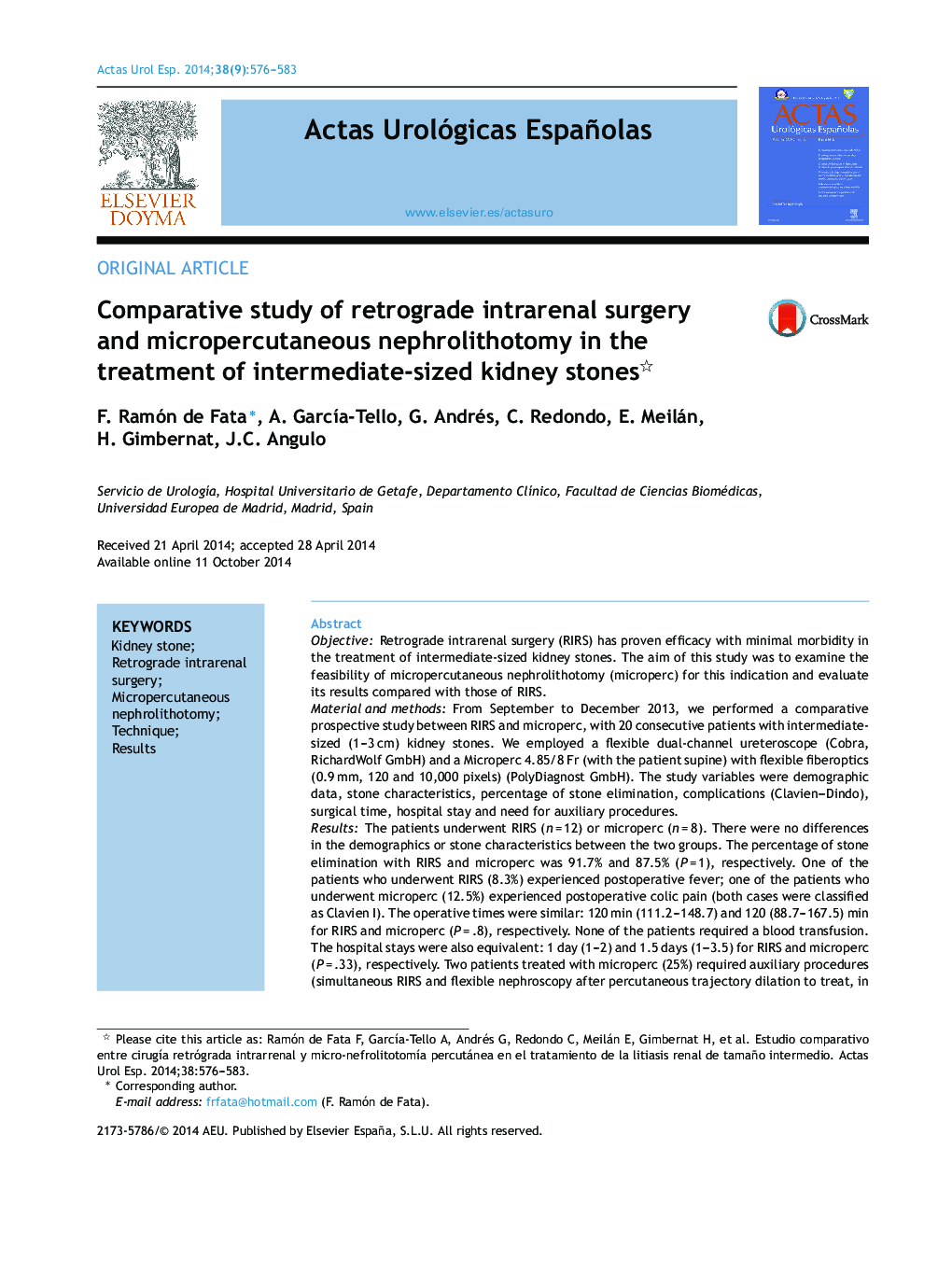| کد مقاله | کد نشریه | سال انتشار | مقاله انگلیسی | نسخه تمام متن |
|---|---|---|---|---|
| 3845408 | 1248265 | 2014 | 8 صفحه PDF | دانلود رایگان |

ObjectiveRetrograde intrarenal surgery (RIRS) has proven efficacy with minimal morbidity in the treatment of intermediate-sized kidney stones. The aim of this study was to examine the feasibility of micropercutaneous nephrolithotomy (microperc) for this indication and evaluate its results compared with those of RIRS.Material and methodsFrom September to December 2013, we performed a comparative prospective study between RIRS and microperc, with 20 consecutive patients with intermediate-sized (1–3 cm) kidney stones. We employed a flexible dual-channel ureteroscope (Cobra, RichardWolf GmbH) and a Microperc 4.85/8 Fr (with the patient supine) with flexible fiberoptics (0.9 mm, 120 and 10,000 pixels) (PolyDiagnost GmbH). The study variables were demographic data, stone characteristics, percentage of stone elimination, complications (Clavien–Dindo), surgical time, hospital stay and need for auxiliary procedures.ResultsThe patients underwent RIRS (n = 12) or microperc (n = 8). There were no differences in the demographics or stone characteristics between the two groups. The percentage of stone elimination with RIRS and microperc was 91.7% and 87.5% (P = 1), respectively. One of the patients who underwent RIRS (8.3%) experienced postoperative fever; one of the patients who underwent microperc (12.5%) experienced postoperative colic pain (both cases were classified as Clavien I). The operative times were similar: 120 min (111.2–148.7) and 120 (88.7–167.5) min for RIRS and microperc (P = .8), respectively. None of the patients required a blood transfusion. The hospital stays were also equivalent: 1 day (1–2) and 1.5 days (1–3.5) for RIRS and microperc (P = .33), respectively. Two patients treated with microperc (25%) required auxiliary procedures (simultaneous RIRS and flexible nephroscopy after percutaneous trajectory dilation to treat, in both cases, a significant fragment that had migrated to an inaccessible calyx), and 1 patient in the RIRS group (8.3%) required percutaneous nephrolithotomy due to unfavorable infundibular-calyceal anatomy (P = .54).ConclusionsMicroperc is a minimally invasive method that is emerging as an effective and safe treatment for intermediate-sized kidney stones. Studies are needed to better evaluate its cost-effectiveness, the need for complementary treatments and its possible complementarity with RIRS when working with patients in the supine position.
ResumenObjetivoLa cirugía retrógrada intrarrenal (CRIR) muestra eficacia contrastada con mínima morbilidad en el tratamiento de la litiasis renal de tamãno intermedio. Se pretende estudiar la viabilidad de micro-nefrolitotomía percutánea (microperc) en esta indicación y evaluar sus resultados de forma comparativa a CRIR.Material y métodosDesde septiembre a diciembre de 2013 realizamos un estudio compara-tivo prospectivo entre CRIR y microperc, en 20 pacientes consecutivos con litiasis renal detamãno intermedio (1-3 cm). Se empleó ureteroscopio flexible de doble canal (Cobra, RichardWolf GmbH) y Microperc 4,85/8 Fr en posición supino con fibra óptica flexible de 0,9 mm y 120∘, 10.000 píxeles (PolyDiagnost GmbH). Las variables analizadas fueron: datos demográficos,características del cálculo, porcentaje de eliminación de litiasis, complicaciones (Clavien-Dindo), tiempo quirúrgico, estancia hospitalaria y necesidad de procedimientos auxiliares.ResultadosLos pacientes recibieron CRIR (n = 12) o microperc (n = 8). No existieron diferencias demográficas ni en las características de la litiasis entre ambos grupos. El porcentaje de eli-minación de litiasis con CRIR fue 91,7% y con microperc 87,5% (p = 1). Un paciente tratado conCRIR (8,3%) tuvo fiebre postoperatoria y otro con microperc (12,5%) dolor cólico postoperato-rio (ambos Clavien I). Los tiempos operatorios fueron similares: CRIR 120 min (111,2---148,7) ymicroperc 120 min (88,7---167,5) (p = 0,8). Ningún paciente necesitó transfusión sanguínea. Laestancia hospitalaria fue también equivalente: CRIR 1 día (1---2) y microperc 1,5 días (1---3,5) (p = 0,33). Dos pacientes tratados con microperc (25%) necesitaron procedimientos accesorios (CRIR simultánea y nefroscopia flexible tras dilatación del trayecto percutáneo para tratar enambos casos un fragmento significativo migrado a un cáliz no accesible) y uno en el grupo CRIR (8,3%) precisó nefrolitotomía percutánea por anatomía infundíbulo-calicial desfavorable (p = 0,54).ConclusionesMicroperc es un método mínimamente invasivo emergente, eficaz y seguro paratratar litiasis renal de tamãno intermedio. Se precisan estudios que evalúen mejor coste-efectividad, la necesidad de tratamientos complementarios y su posible complementariedadcon CRIR cuando se trabaja en posición supina.
Journal: Actas Urológicas Españolas (English Edition) - Volume 38, Issue 9, November 2014, Pages 576–583